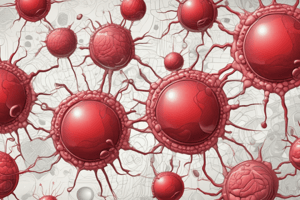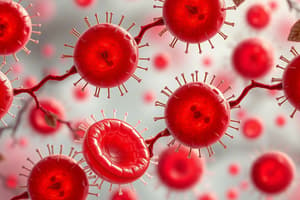Podcast
Questions and Answers
What percentage of total leukocytes are neutrophils in an adult?
What percentage of total leukocytes are neutrophils in an adult?
- 20 – 30
- 2 – 10
- 1 – 4
- 50 – 70 (correct)
What is the typical diameter of a neutrophil?
What is the typical diameter of a neutrophil?
- 20 – 25 µm
- 14 – 19 µm
- 10 – 12 µm (correct)
- 6 – 8 µm
What is the shape of the nucleus in a monocyte?
What is the shape of the nucleus in a monocyte?
- Round
- Irregular
- Kidney-shaped (correct)
- Lobulated
What is the function of the granules in the cytoplasm of neutrophils?
What is the function of the granules in the cytoplasm of neutrophils?
What is the term for leukocytes with nuclei consisting of multiple lobes?
What is the term for leukocytes with nuclei consisting of multiple lobes?
What percentage of total leukocytes are lymphocytes in an adult?
What percentage of total leukocytes are lymphocytes in an adult?
What is the purpose of adding cedar wood oil to the smear?
What is the purpose of adding cedar wood oil to the smear?
What is the typical percentage of eosinophils in total WBCs?
What is the typical percentage of eosinophils in total WBCs?
What is the minimum number of white blood cells that should be counted for a reliable result?
What is the minimum number of white blood cells that should be counted for a reliable result?
What is the characteristic shape of the nucleus in basophils?
What is the characteristic shape of the nucleus in basophils?
What is the term for an increase in the number of circulating neutrophils?
What is the term for an increase in the number of circulating neutrophils?
What is the reason for a slight increase in neutrophils under physiological conditions?
What is the reason for a slight increase in neutrophils under physiological conditions?
What is the primary function of lymphocytes?
What is the primary function of lymphocytes?
What is the purpose of the Leishman's stain in the blood film preparation?
What is the purpose of the Leishman's stain in the blood film preparation?
What is the typical size range of small lymphocytes?
What is the typical size range of small lymphocytes?
What is the final step in the differential count of white blood cells?
What is the final step in the differential count of white blood cells?
What is unique about the cytoplasm of monocytes?
What is unique about the cytoplasm of monocytes?
What is the normal percentage of monocytes in total WBCs?
What is the normal percentage of monocytes in total WBCs?
Which of the following conditions is associated with eosinopenia?
Which of the following conditions is associated with eosinopenia?
Which of the following is a cause of neutropenia?
Which of the following is a cause of neutropenia?
Which of the following diseases is associated with monocytosis?
Which of the following diseases is associated with monocytosis?
Which of the following conditions is associated with lymphocytosis?
Which of the following conditions is associated with lymphocytosis?
Which of the following is a cause of basophilia?
Which of the following is a cause of basophilia?
Which of the following conditions is associated with lymphocytopenia?
Which of the following conditions is associated with lymphocytopenia?
Flashcards
Leukocytes
Leukocytes
White blood cells (WBCs) that play a key role in the immune system, fighting infections and protecting the body.
Polymorphonuclear Leukocytes (PMNs)
Polymorphonuclear Leukocytes (PMNs)
WBCs with multi-lobed nuclei and cytoplasmic granules. They are also known as granulocytes.
Neutrophils
Neutrophils
The most abundant type of WBC, responsible for engulfing and destroying bacteria through phagocytosis.
Eosinophils
Eosinophils
Signup and view all the flashcards
Basophils
Basophils
Signup and view all the flashcards
Lymphocytes
Lymphocytes
Signup and view all the flashcards
Monocytes
Monocytes
Signup and view all the flashcards
Differential Leukocyte Count
Differential Leukocyte Count
Signup and view all the flashcards
Neutrophilia
Neutrophilia
Signup and view all the flashcards
Neutropenia
Neutropenia
Signup and view all the flashcards
Lymphocytosis
Lymphocytosis
Signup and view all the flashcards
Lymphocytopenia
Lymphocytopenia
Signup and view all the flashcards
Eosinophilia
Eosinophilia
Signup and view all the flashcards
Eosinopenia
Eosinopenia
Signup and view all the flashcards
Basophilia
Basophilia
Signup and view all the flashcards
Monocytosis
Monocytosis
Signup and view all the flashcards
Study Notes
Leukocytes
- There are 5 types of leukocytes: neutrophils, eosinophils, basophils, lymphocytes, and monocytes.
Polymorphonuclear Leukocytes
- Have nuclei consisting of a number of lobes
- Also called granulocytes due to small granules in their cytoplasm
- 3 types: neutrophils, eosinophils, and basophils
Neutrophils
- Diameter: 10-12 µm
- Nucleus: 2-5 lobes, densely staining
- Cytoplasm: fine dark-blue or purple granules, lysosomal in nature, able to kill bacteria
- Percentage: 50-70% of total WBCs
Eosinophils
- Diameter: 10-12 µm
- Nucleus: usually 2 lobes
- Cytoplasm: densely packed with large oval granules, staining bright red or orange
- Percentage: 1-4% of total WBCs
Basophils
- Diameter: 8-10 µm
- Nucleus: irregular, divided into 2 lobes (S-shape)
- Cytoplasm: contains dark-blue granules, containing heparin and histamine
- Percentage: <1% of total WBCs
Lymphocytes
- Concerned with antibody formation
- Two forms: small (6-8 µm) and large (12-16 µm)
- Small lymphocytes: round nucleus, densely staining condensed chromatin, thin rim, blue cytoplasm
- Large lymphocytes: more plentiful cytoplasm, staining pale blue, sometimes showing a few granules
- Percentage: 20-45% of total WBCs
Monocytes
- Largest white blood cells
- Nucleus: irregular shape, fine chromatin, often kidney-shaped (Reni form)
- Cytoplasm: blue-gray color, "ground-glass" appearance, contains lysosomal granules and vacuoles
- Percentage: 2-10% of total WBCs
Differential Leukocyte Count
- Performed by examining a blood film stained with Leishman's stain under immersion oil
- Apparatus and reagents: glass slide, Leishman's stain, cedar wood oil, microscope
- Procedure: prepare and stain blood film, examine under immersion oil, count at least 100 WBCs, record count, and calculate percentage of each type of cell
Variations in Leukocyte Count
- Neutrophilia (increase in neutrophils): seen in acute pyogenic infections, physiological conditions, and certain diseases
- Neutropenia (decrease in neutrophils): seen in typhoid and paratyphoid fever, malaria, aplastic anemia, and certain drug treatments
- Lymphocytosis (increase in lymphocytes): seen in chronic infections, tuberculosis, and whooping cough
- Lymphocytopenia (decrease in lymphocytes): seen in patients on ACTH and steroid therapy
- Eosinophilia (increase in eosinophils): seen in allergic conditions, pulmonary eosinophilia, and intestinal infestation with worms
- Eosinopenia (decrease in eosinophils): seen in acute pyogenic infections and patients on ACTH and steroid therapy
- Basophilia (increase in basophils): seen in chronic myeloid leukemia, small pox, and polycythemia
- Monocytosis (increase in monocytes): seen in infectious mononucleosis, malaria, and kala azar
Studying That Suits You
Use AI to generate personalized quizzes and flashcards to suit your learning preferences.




